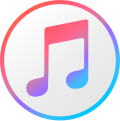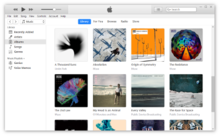
The iPod is a discontinued series of portable media players and multi-purpose mobile devices designed and marketed by Apple Inc. The first version was released on November 10, 2001, about 8+1⁄2 months after the Macintosh version of iTunes was released. Apple sold an estimated 450 million iPod products as of 2022. Apple discontinued the iPod product line on May 10, 2022. At over 20 years, the iPod brand is the oldest to be discontinued by Apple.
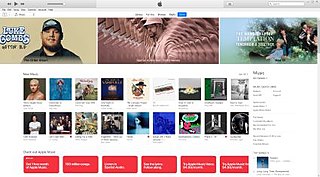
The iTunes Store is a digital media store operated by Apple Inc. It opened on April 28, 2003, as a result of Steve Jobs' push to open a digital marketplace for music. As of April 2020, iTunes offered 60 million songs, 2.2 million apps, 25,000 TV shows, and 65,000 films. When it opened, it was the only legal digital catalog of music to offer songs from all five major record labels.

iLife is a discontinued software suite for macOS and iOS developed by Apple Inc. It consists of various programs for media creation, organization, editing and publishing. At various times, it included: iTunes, iMovie, iPhoto, iDVD, iWeb, and GarageBand. Only iMovie and GarageBand remain and are now freely available on Apple's Mac App Store. iDVD and iWeb have been discontinued while iTunes and iPhoto have been succeeded by Music and Photos respectively.
FairPlay is a family of digital rights management (DRM) technologies developed by Apple Inc. for protecting videos, books and apps and historically for music.
The Apple Lossless Audio Codec (ALAC), also known as Apple Lossless, or Apple Lossless Encoder (ALE), is an audio coding format, and its reference audio codec implementation, developed by Apple Inc. for lossless data compression of digital music. After initially keeping it proprietary from its inception in 2004, in late 2011 Apple made the codec available open source and royalty-free. Traditionally, Apple has referred to the codec as Apple Lossless, though more recently it has begun to use the abbreviated term ALAC when referring to the codec.

The iTunes media platform was first released by Apple in 2001 as a simple music player for Mac computers. Over time, iTunes developed into a sophisticated multimedia content manager, hardware synchronization manager and e-commerce platform. iTunes was finally discontinued for new Mac computers in 2019, but is still available and supported for Macs running older operating systems and for Windows computers to ensure updated compatibility for syncing with new releases of iOS devices.
doubleTwist Corporation is a digital media company founded by Monique Farantzos and Jon Lech Johansen. It is backed by Index Ventures and Northzone Ventures.
Amazon Music is a music streaming platform and Digital music store operated by Amazon. As of January 2020, the service had 55 million subscribers.
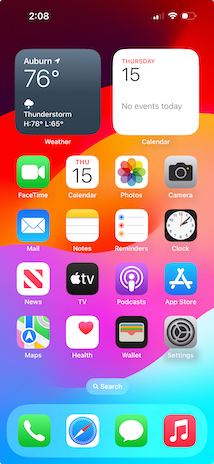
iOS is a mobile operating system developed by Apple Inc. exclusively for its smartphones. It was unveiled in January 2007 for the first-generation iPhone, launched in June 2007.
A .ipa file is an iOS and iPadOS application archive file which stores an iOS/iPadOS app. Each .ipa file includes a binary and can only be installed on an iOS, iPadOS, or ARM-based macOS device. Files with the .ipa extension can be uncompressed by changing the extension to .zip and unzipping. This is only recommended when editing the app itself. Some ipa's will not have a .app file.

iCloud is a cloud service developed by Apple Inc. Launched on October 12, 2011, iCloud enables users to store and sync data across devices, including Apple Mail, Apple Calendar, Apple Photos, Apple Notes, contacts, settings, backups, and files, to collaborate with other users, and track assets through Find My. It is built into iOS, iPadOS, watchOS, tvOS, macOS, and visionOS. iCloud may additionally be accessed through a limited web interface and Windows application.
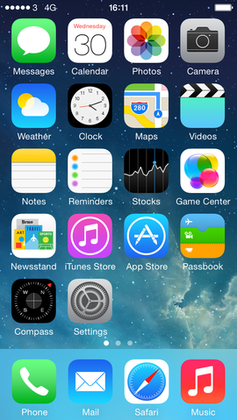
iOS 7 is the seventh major release of the iOS mobile operating system developed by Apple Inc., being the successor to iOS 6. It was announced at the company's Worldwide Developers Conference on June 10, 2013, and was released on September 18 of that year. It was succeeded by iOS 8 on September 17, 2014.

iOS 8 is the eighth major release of the iOS mobile operating system developed by Apple Inc., being the successor to iOS 7. It was announced at the company's Worldwide Developers Conference on June 2, 2014, and was released on September 17, 2014. It was succeeded by iOS 9 on September 16, 2015.

OS X Yosemite is the eleventh major release of macOS, Apple Inc.'s desktop and server operating system for Macintosh computers.
Apple Music is an audio and video streaming service developed by Apple Inc. Users select music to stream to their device on-demand, or they can listen to existing playlists. The service also includes the sister internet radio stations Apple Music 1, Apple Music Hits, and Apple Music Country, which are broadcast live to over 200 countries 24 hours a day. The service was announced on June 8, 2015, and launched on June 30, 2015. New subscribers get a one-month free or six months free trial with the purchase of select products before the service requires a monthly subscription.

macOS Sierra is the thirteenth major release of macOS, Apple Inc.'s desktop and server operating system for Macintosh computers. The name "macOS" stems from the intention to unify the operating system's name with that of iOS, watchOS and tvOS. Sierra is named after the Sierra Nevada mountain range in California and Nevada. Its major new features concern Continuity, iCloud, and windowing, as well as support for Apple Pay and Siri.

Music is a media player application developed for the iOS, iPadOS, macOS, watchOS, visionOS, tvOS, Android, and Windows 11 operating systems by Apple Inc. It can play music files stored locally on devices, as well as stream from the iTunes Store and Apple Music.
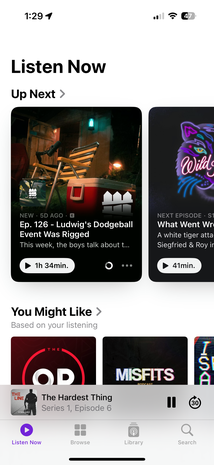
Apple Podcasts is an audio streaming service and media player application developed by Apple Inc. for playing podcasts. Apple began supporting podcasts with iTunes 4.9 released in June 2005 and launched its first standalone mobile app in 2012. The app was later pre-installed with iOS beginning October 2014. The Apple Podcasts directory features more than two million shows. Apple Podcasts is available on iOS, iPadOS, macOS, watchOS, tvOS, CarPlay, Microsoft Windows operating systems, and on Amazon Alexa devices.
